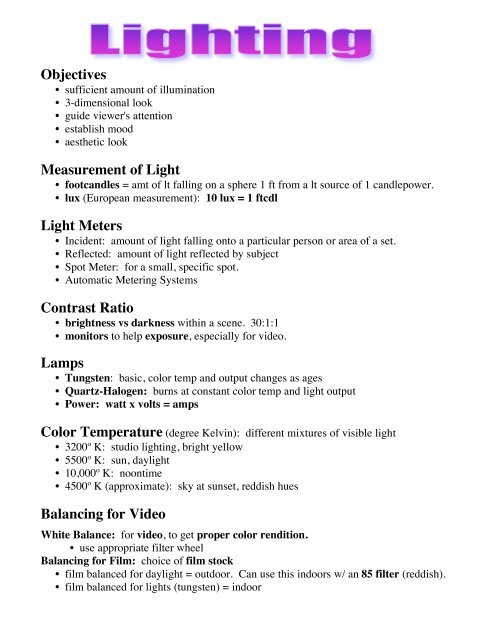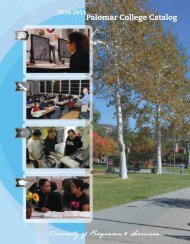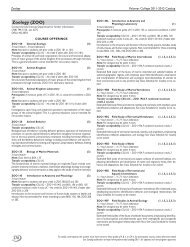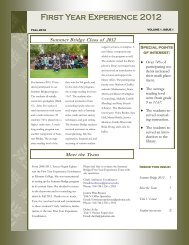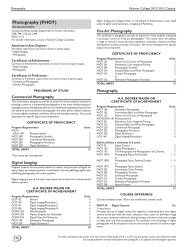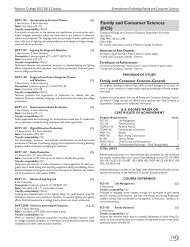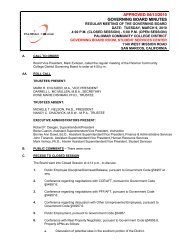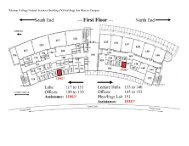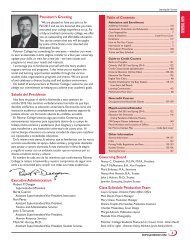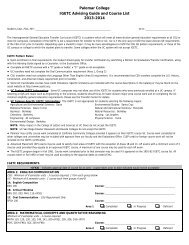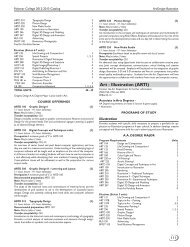Objectives Measurement of Light Light Meters Contrast Ratio Lamps ...
Objectives Measurement of Light Light Meters Contrast Ratio Lamps ...
Objectives Measurement of Light Light Meters Contrast Ratio Lamps ...
You also want an ePaper? Increase the reach of your titles
YUMPU automatically turns print PDFs into web optimized ePapers that Google loves.
<strong>Objectives</strong><br />
• sufficient amount <strong>of</strong> illumination<br />
• 3-dimensional look<br />
• guide viewer's attention<br />
• establish mood<br />
• aesthetic look<br />
<strong>Measurement</strong> <strong>of</strong> <strong>Light</strong><br />
• footcandles = amt <strong>of</strong> lt falling on a sphere 1 ft from a lt source <strong>of</strong> 1 candlepower.<br />
• lux (European measurement): 10 lux = 1 ftcdl<br />
<strong>Light</strong> <strong>Meters</strong><br />
• Incident: amount <strong>of</strong> light falling onto a particular person or area <strong>of</strong> a set.<br />
• Reflected: amount <strong>of</strong> light reflected by subject<br />
• Spot Meter: for a small, specific spot.<br />
• Automatic Metering Systems<br />
<strong>Contrast</strong> <strong>Ratio</strong><br />
• brightness vs darkness within a scene. 30:1:1<br />
• monitors to help exposure, especially for video.<br />
<strong>Lamps</strong><br />
• Tungsten: basic, color temp and output changes as ages<br />
• Quartz-Halogen: burns at constant color temp and light output<br />
• Power: watt x volts = amps<br />
Color Temperature (degree Kelvin): different mixtures <strong>of</strong> visible light<br />
• 3200º K: studio lighting, bright yellow<br />
• 5500º K: sun, daylight<br />
• 10,000º K: noontime<br />
• 4500º K (approximate): sky at sunset, reddish hues<br />
Balancing for Video<br />
White Balance: for video, to get proper color rendition.<br />
• use appropriate filter wheel<br />
Balancing for Film: choice <strong>of</strong> film stock<br />
• film balanced for daylight = outdoor. Can use this indoors w/ an 85 filter (reddish).<br />
• film balanced for lights (tungsten) = indoor
<strong>Light</strong>s<br />
Spotlights: fresnels, ellipsoidal, lensless spots, HMI (outdoor use), follow spots<br />
Floodlights: scoop, s<strong>of</strong>t, broads, strip<br />
Control Beam <strong>of</strong> <strong>Light</strong><br />
Barndoors<br />
Snoots<br />
Flags: rectangular metal pieces to block part <strong>of</strong> light<br />
Shutters: for lekos<br />
Cookies<br />
Control <strong>Light</strong> Intensity<br />
Scrims/spun/screens<br />
Diffusion material<br />
• silk: white artificial material, cuts down volume <strong>of</strong> light, have metal frames<br />
• net: looks like mosquito netting, diffuse lighting slightly, less than scrims<br />
• frost & tough white: milky-looking gels (cellophane-like material)<br />
<strong>Light</strong>ing Methods<br />
3-Point: Key / Fill / Back - keep in mind, indoors & out, use sun<br />
Available <strong>Light</strong>: note where light is coming from<br />
Camera Placement: note best areas and consider that when placing your camera<br />
Windows: don't shoot with window in background = silhouette, unless going for that<br />
effect<br />
• Blue filter or light-blue color gel: to raise the color temp <strong>of</strong> indoor light to outdoor<br />
light (3200º K to 5600º K)<br />
• <strong>Light</strong>-Orange filter material to window: to lower outdoor lt (3200º K to 5500º K)<br />
Sun: don't shoot at it = silhouette. Use it as key.<br />
Reflector Boards: use to bounce light to subject. Large white boards, crinkled foil.<br />
Time <strong>of</strong> Day: consider best time <strong>of</strong> day. 11 am-2 pm can be difficult due to intense sun.<br />
• early morning/late afternoon: greater sense <strong>of</strong> relief, more dramatic image<br />
• color tones: different at different times <strong>of</strong> day, warmer in late afternoon<br />
Fall<strong>of</strong>f: the degree <strong>of</strong> change from light to shadow<br />
• Slow: more gradual change<br />
• Fast: abrupt change from light to shadow, high contrast<br />
Film-Style <strong>Light</strong>ing<br />
Changes for every shot.<br />
Work with stocks, can shoot with lower light levels. Greater contrast range.
<strong>Light</strong>ing For Movement<br />
<strong>Light</strong>ing plot: diagram <strong>of</strong> set that shows camera position, location <strong>of</strong> lights, their size, type<br />
and direction.<br />
Easiest way: illuminate the entire area with s<strong>of</strong>t, diffused lighting.<br />
Common way: 3-point in areas needed, fill in gaps w/ fill light.<br />
Overlapping: areas <strong>of</strong> key, fill, back.<br />
• Use same lights for different purposes.<br />
• Use meters: incident and reflective<br />
To Avoid Shadows: more pronounced against a light-colored backgrd.<br />
• Adjust lights to a different angle.<br />
• Place shadows out <strong>of</strong> frame.<br />
• Place actors further away from wall.<br />
• Use flags or barndoors to block <strong>of</strong>f light that is causing shadow.<br />
• Move boom or don't use it.<br />
• Change quality <strong>of</strong> light: diffuse, s<strong>of</strong>ten<br />
<strong>Light</strong>ing <strong>Ratio</strong>: relates to the ratio <strong>of</strong> the key to the fill.<br />
Film: most common is 3:1 (has a 1 1/2 f-stop difference)<br />
Video: 2:1 or 3:1.<br />
High-key lighting: bright, even illumination. Key-to-fill is low, low-contrast. Bright,<br />
happy and relatively flat.<br />
Low-key lighting: shadowy. Key-to-fill is high, high-contrast. Darker, brooding, harsh.<br />
Emotional impact <strong>of</strong> lighting: depends on direction, angle, quality (hard or s<strong>of</strong>t).<br />
Front: tends to reduce shadows and flatten image. If s<strong>of</strong>t & diffused, smoothes out the<br />
texture <strong>of</strong> surface illuminated.<br />
Side: sharper shadows. Models the subject and can highlight the texture with small<br />
shadows.<br />
Back: emphasizes depth.<br />
Angled: from above or below create more distinct, dramatic shadows.<br />
Use fewer lights what with faster lenses and more sensitive imaging systems.


